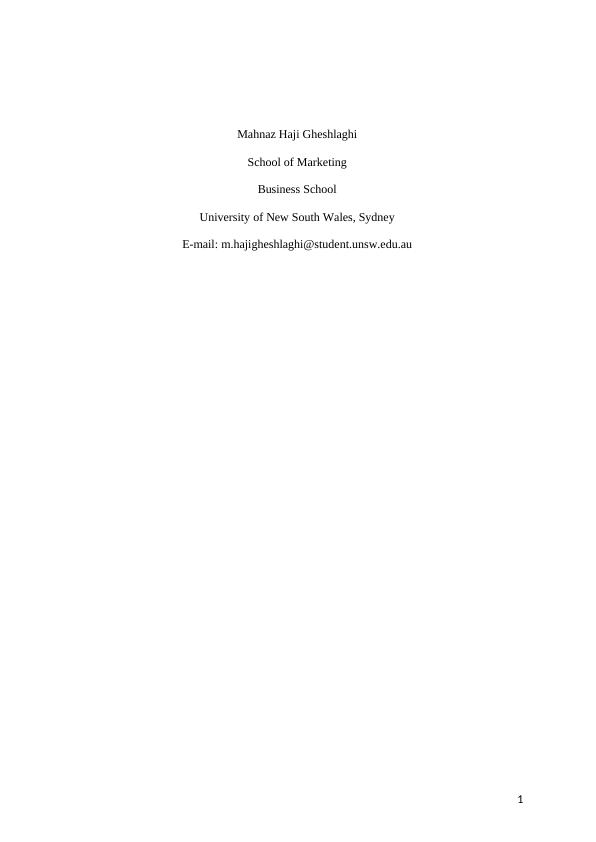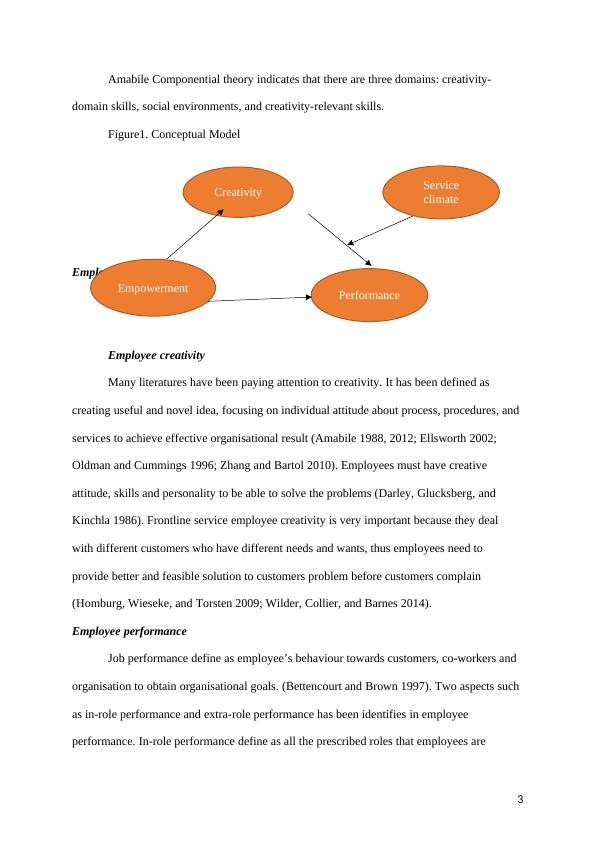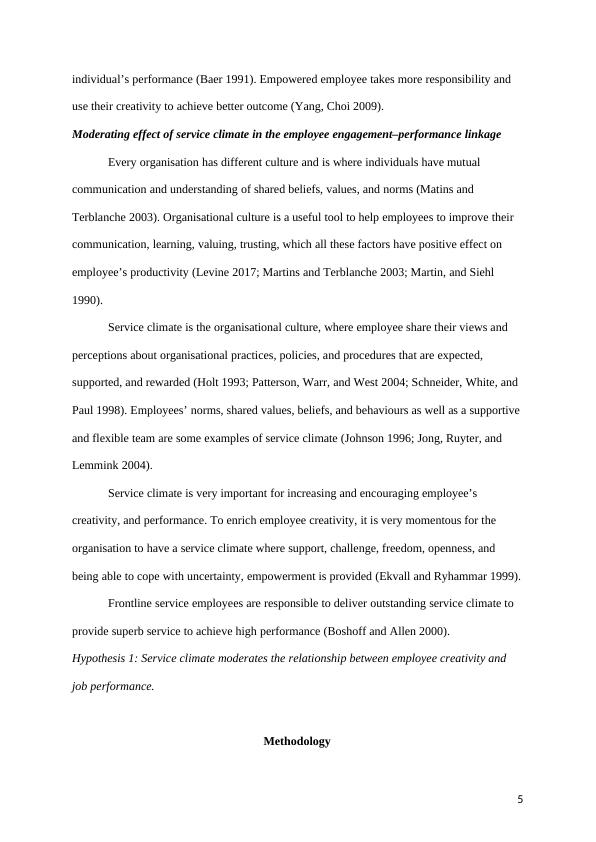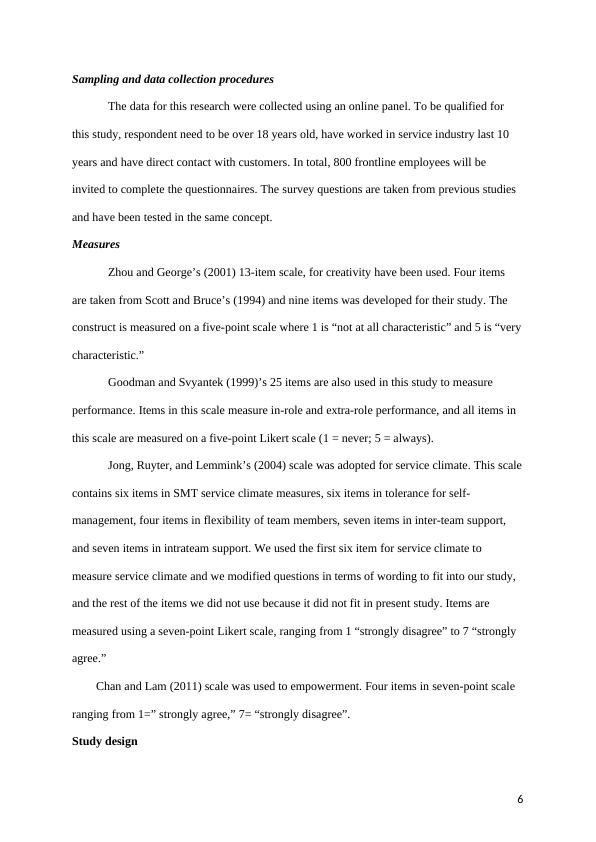Ask a question from expert
Frontline Service Employees Empowerment, Creativity, and Job Performance Introduction
21 Pages5742 Words269 Views
University of New South Wales
Quantitative Research Methods (COMM8002)
Added on 2021-09-16
About This Document
Mahnaz Haji Gheshlaghi School of Marketing Business School University of New South Wales, Sydney E-mail: m.hajigheshlaghi@student.unsw.edu.au Frontline Service Employees Empowerment, Creativity, and Job Performance Introduction Today’s marketplace is massively competitive, so many companies must recognise customers’ needs and wants and provide and offer better service, and solution for customers problems (Lovelock, Patterson, and Wirtz 2011). It is highly required that if frontline service
Frontline Service Employees Empowerment, Creativity, and Job Performance Introduction
University of New South Wales
Quantitative Research Methods (COMM8002)
Added on 2021-09-16
BookmarkShareRelated Documents

Frontline Service Employees Empowerment, Creativity, and Job Performance
Introduction
Today’s marketplace is massively competitive, so many companies must recognise
customers’ needs and wants and provide and offer better service, and solution for customers
problems (Lovelock, Patterson, and Wirtz 2011). Amabile et al. (1996) states that employees
creativity has significant role to play to achieve organisational innovation, effectiveness, and
performance. It is highly required that if frontline service employees, who want to deliver
outstanding service need to demonstrate creativity as each customer has different wants and
needs (Wilder, Collier, and Barnes 2014).
Consequently, this study examines how frontline service employees’ empowerment
relates to their creativity and job performance. Precisely, this research tests the model, where
creativity is as the mediating role between employee empowerment and performance and
service climate used as moderating effect between creativity and performance.
Literature Review
Conceptual framework
The conceptual model is presented in figure 1. The model illustrates that frontline
service employee empowerment is related to job performance through creativity. It also
hypothesis that service climate (organisational culture) can influence on constructs of this
study.
In this study the conceptual model is understood as the componential theory of
creativity proposed by Amabile (1983). Amabile (1988) states that creativity is essential in
the organisation to solve problems, deal with uncertainties, and achieve superb outcome.
2
Introduction
Today’s marketplace is massively competitive, so many companies must recognise
customers’ needs and wants and provide and offer better service, and solution for customers
problems (Lovelock, Patterson, and Wirtz 2011). Amabile et al. (1996) states that employees
creativity has significant role to play to achieve organisational innovation, effectiveness, and
performance. It is highly required that if frontline service employees, who want to deliver
outstanding service need to demonstrate creativity as each customer has different wants and
needs (Wilder, Collier, and Barnes 2014).
Consequently, this study examines how frontline service employees’ empowerment
relates to their creativity and job performance. Precisely, this research tests the model, where
creativity is as the mediating role between employee empowerment and performance and
service climate used as moderating effect between creativity and performance.
Literature Review
Conceptual framework
The conceptual model is presented in figure 1. The model illustrates that frontline
service employee empowerment is related to job performance through creativity. It also
hypothesis that service climate (organisational culture) can influence on constructs of this
study.
In this study the conceptual model is understood as the componential theory of
creativity proposed by Amabile (1983). Amabile (1988) states that creativity is essential in
the organisation to solve problems, deal with uncertainties, and achieve superb outcome.
2

Amabile Componential theory indicates that there are three domains: creativity-
domain skills, social environments, and creativity-relevant skills.
Figure1. Conceptual Model
Employee creativity
Employee creativity
Many literatures have been paying attention to creativity. It has been defined as
creating useful and novel idea, focusing on individual attitude about process, procedures, and
services to achieve effective organisational result (Amabile 1988, 2012; Ellsworth 2002;
Oldman and Cummings 1996; Zhang and Bartol 2010). Employees must have creative
attitude, skills and personality to be able to solve the problems (Darley, Glucksberg, and
Kinchla 1986). Frontline service employee creativity is very important because they deal
with different customers who have different needs and wants, thus employees need to
provide better and feasible solution to customers problem before customers complain
(Homburg, Wieseke, and Torsten 2009; Wilder, Collier, and Barnes 2014).
Employee performance
Job performance define as employee’s behaviour towards customers, co-workers and
organisation to obtain organisational goals. (Bettencourt and Brown 1997). Two aspects such
as in-role performance and extra-role performance has been identifies in employee
performance. In-role performance define as all the prescribed roles that employees are
Service
climateCreativity
Empowerment Performance
3
domain skills, social environments, and creativity-relevant skills.
Figure1. Conceptual Model
Employee creativity
Employee creativity
Many literatures have been paying attention to creativity. It has been defined as
creating useful and novel idea, focusing on individual attitude about process, procedures, and
services to achieve effective organisational result (Amabile 1988, 2012; Ellsworth 2002;
Oldman and Cummings 1996; Zhang and Bartol 2010). Employees must have creative
attitude, skills and personality to be able to solve the problems (Darley, Glucksberg, and
Kinchla 1986). Frontline service employee creativity is very important because they deal
with different customers who have different needs and wants, thus employees need to
provide better and feasible solution to customers problem before customers complain
(Homburg, Wieseke, and Torsten 2009; Wilder, Collier, and Barnes 2014).
Employee performance
Job performance define as employee’s behaviour towards customers, co-workers and
organisation to obtain organisational goals. (Bettencourt and Brown 1997). Two aspects such
as in-role performance and extra-role performance has been identifies in employee
performance. In-role performance define as all the prescribed roles that employees are
Service
climateCreativity
Empowerment Performance
3

required by the organisation to fulfil and extra-role performance that refers to non-prescribed
role (helping colleagues with their personal problems) that individuals fulfil (Mackenzie,
Podsakoff, and Ahearne 1998; Bettencourt and Brown 1997).
Employee Empowerment
Empowered employee can be engaged in discretionary behaviour for the purpose of
helping a customer to meet their expectations (Klidas, Berg, and Wilderson 2007).
Empowerment gives employees the authority to make decision independently, and be more
creative (Klidas, Berg, and Wilderson 2007). For example, taking instant action to solve
customer problem even if the problem is not related to employee (e.g., giving customers a
discount).
Linking Empowerment to employee creativity
Empowered employee uses their creativity and does whatever it takes to make
customer satisfy as customers are willing to get quick fix for their issues and they don’t like
to hear “this is against rules” (Brymer 1991; Jones, Tylor, and Nickson 1997; Lashley 1997).
Empowerment decreases employee stress and leads them to innovative behaviour and believe
in themselves. Empowerment has a significant positive effect on employees’ task
performance and loyalty, mediated by employees’ satisfaction (Yao, Chen, and Gouliang
(2013).
Employee creativity as a mediator in the Empowerment and performance linkage
Job performance mostly relies on frontline service employees in service context
because they creative thinking encourages them to generate new ideas to solve customer
problems and facilitate excellent customer purchase experience (Zeithaml, Parasuraman, and
Berry 1990). Creativity as an individual personality trait, individual can use for problem-
solving and that shapes the habit of thoughts and attitudes, which then influences the
4
role (helping colleagues with their personal problems) that individuals fulfil (Mackenzie,
Podsakoff, and Ahearne 1998; Bettencourt and Brown 1997).
Employee Empowerment
Empowered employee can be engaged in discretionary behaviour for the purpose of
helping a customer to meet their expectations (Klidas, Berg, and Wilderson 2007).
Empowerment gives employees the authority to make decision independently, and be more
creative (Klidas, Berg, and Wilderson 2007). For example, taking instant action to solve
customer problem even if the problem is not related to employee (e.g., giving customers a
discount).
Linking Empowerment to employee creativity
Empowered employee uses their creativity and does whatever it takes to make
customer satisfy as customers are willing to get quick fix for their issues and they don’t like
to hear “this is against rules” (Brymer 1991; Jones, Tylor, and Nickson 1997; Lashley 1997).
Empowerment decreases employee stress and leads them to innovative behaviour and believe
in themselves. Empowerment has a significant positive effect on employees’ task
performance and loyalty, mediated by employees’ satisfaction (Yao, Chen, and Gouliang
(2013).
Employee creativity as a mediator in the Empowerment and performance linkage
Job performance mostly relies on frontline service employees in service context
because they creative thinking encourages them to generate new ideas to solve customer
problems and facilitate excellent customer purchase experience (Zeithaml, Parasuraman, and
Berry 1990). Creativity as an individual personality trait, individual can use for problem-
solving and that shapes the habit of thoughts and attitudes, which then influences the
4

individual’s performance (Baer 1991). Empowered employee takes more responsibility and
use their creativity to achieve better outcome (Yang, Choi 2009).
Moderating effect of service climate in the employee engagement–performance linkage
Every organisation has different culture and is where individuals have mutual
communication and understanding of shared beliefs, values, and norms (Matins and
Terblanche 2003). Organisational culture is a useful tool to help employees to improve their
communication, learning, valuing, trusting, which all these factors have positive effect on
employee’s productivity (Levine 2017; Martins and Terblanche 2003; Martin, and Siehl
1990).
Service climate is the organisational culture, where employee share their views and
perceptions about organisational practices, policies, and procedures that are expected,
supported, and rewarded (Holt 1993; Patterson, Warr, and West 2004; Schneider, White, and
Paul 1998). Employees’ norms, shared values, beliefs, and behaviours as well as a supportive
and flexible team are some examples of service climate (Johnson 1996; Jong, Ruyter, and
Lemmink 2004).
Service climate is very important for increasing and encouraging employee’s
creativity, and performance. To enrich employee creativity, it is very momentous for the
organisation to have a service climate where support, challenge, freedom, openness, and
being able to cope with uncertainty, empowerment is provided (Ekvall and Ryhammar 1999).
Frontline service employees are responsible to deliver outstanding service climate to
provide superb service to achieve high performance (Boshoff and Allen 2000).
Hypothesis 1: Service climate moderates the relationship between employee creativity and
job performance.
Methodology
5
use their creativity to achieve better outcome (Yang, Choi 2009).
Moderating effect of service climate in the employee engagement–performance linkage
Every organisation has different culture and is where individuals have mutual
communication and understanding of shared beliefs, values, and norms (Matins and
Terblanche 2003). Organisational culture is a useful tool to help employees to improve their
communication, learning, valuing, trusting, which all these factors have positive effect on
employee’s productivity (Levine 2017; Martins and Terblanche 2003; Martin, and Siehl
1990).
Service climate is the organisational culture, where employee share their views and
perceptions about organisational practices, policies, and procedures that are expected,
supported, and rewarded (Holt 1993; Patterson, Warr, and West 2004; Schneider, White, and
Paul 1998). Employees’ norms, shared values, beliefs, and behaviours as well as a supportive
and flexible team are some examples of service climate (Johnson 1996; Jong, Ruyter, and
Lemmink 2004).
Service climate is very important for increasing and encouraging employee’s
creativity, and performance. To enrich employee creativity, it is very momentous for the
organisation to have a service climate where support, challenge, freedom, openness, and
being able to cope with uncertainty, empowerment is provided (Ekvall and Ryhammar 1999).
Frontline service employees are responsible to deliver outstanding service climate to
provide superb service to achieve high performance (Boshoff and Allen 2000).
Hypothesis 1: Service climate moderates the relationship between employee creativity and
job performance.
Methodology
5

Sampling and data collection procedures
The data for this research were collected using an online panel. To be qualified for
this study, respondent need to be over 18 years old, have worked in service industry last 10
years and have direct contact with customers. In total, 800 frontline employees will be
invited to complete the questionnaires. The survey questions are taken from previous studies
and have been tested in the same concept.
Measures
Zhou and George’s (2001) 13-item scale, for creativity have been used. Four items
are taken from Scott and Bruce’s (1994) and nine items was developed for their study. The
construct is measured on a five-point scale where 1 is “not at all characteristic” and 5 is “very
characteristic.”
Goodman and Svyantek (1999)’s 25 items are also used in this study to measure
performance. Items in this scale measure in-role and extra-role performance, and all items in
this scale are measured on a five-point Likert scale (1 = never; 5 = always).
Jong, Ruyter, and Lemmink’s (2004) scale was adopted for service climate. This scale
contains six items in SMT service climate measures, six items in tolerance for self-
management, four items in flexibility of team members, seven items in inter-team support,
and seven items in intrateam support. We used the first six item for service climate to
measure service climate and we modified questions in terms of wording to fit into our study,
and the rest of the items we did not use because it did not fit in present study. Items are
measured using a seven-point Likert scale, ranging from 1 “strongly disagree” to 7 “strongly
agree.”
Chan and Lam (2011) scale was used to empowerment. Four items in seven-point scale
ranging from 1=” strongly agree,” 7= “strongly disagree”.
Study design
6
The data for this research were collected using an online panel. To be qualified for
this study, respondent need to be over 18 years old, have worked in service industry last 10
years and have direct contact with customers. In total, 800 frontline employees will be
invited to complete the questionnaires. The survey questions are taken from previous studies
and have been tested in the same concept.
Measures
Zhou and George’s (2001) 13-item scale, for creativity have been used. Four items
are taken from Scott and Bruce’s (1994) and nine items was developed for their study. The
construct is measured on a five-point scale where 1 is “not at all characteristic” and 5 is “very
characteristic.”
Goodman and Svyantek (1999)’s 25 items are also used in this study to measure
performance. Items in this scale measure in-role and extra-role performance, and all items in
this scale are measured on a five-point Likert scale (1 = never; 5 = always).
Jong, Ruyter, and Lemmink’s (2004) scale was adopted for service climate. This scale
contains six items in SMT service climate measures, six items in tolerance for self-
management, four items in flexibility of team members, seven items in inter-team support,
and seven items in intrateam support. We used the first six item for service climate to
measure service climate and we modified questions in terms of wording to fit into our study,
and the rest of the items we did not use because it did not fit in present study. Items are
measured using a seven-point Likert scale, ranging from 1 “strongly disagree” to 7 “strongly
agree.”
Chan and Lam (2011) scale was used to empowerment. Four items in seven-point scale
ranging from 1=” strongly agree,” 7= “strongly disagree”.
Study design
6

End of preview
Want to access all the pages? Upload your documents or become a member.
Related Documents
Frontline Service Employee Engagement PDFlg...
|32
|12140
|105
Can Service Robot Job Creativity, Engagement, and Performance Be as Effective as Human Frontline Service Employeeslg...
|10
|2709
|86
Ph.D. Research Proposal: Are AI-enabled Robots as Effective as Human Frontline Service Employees?lg...
|8
|2923
|379